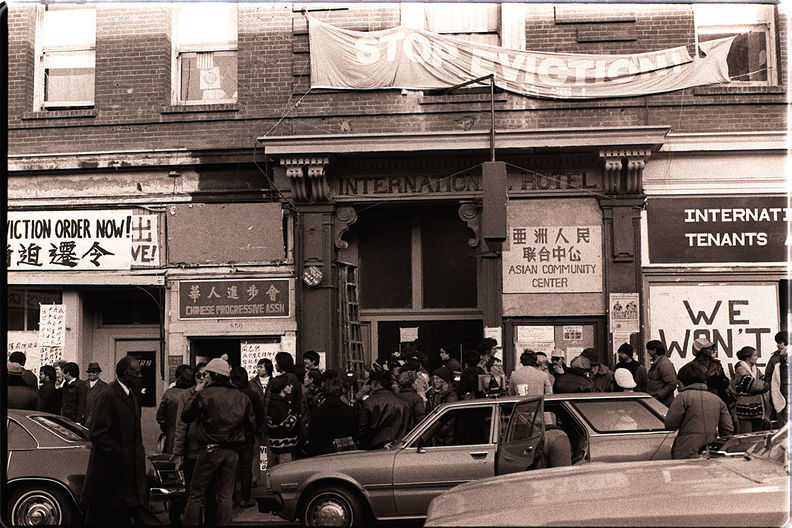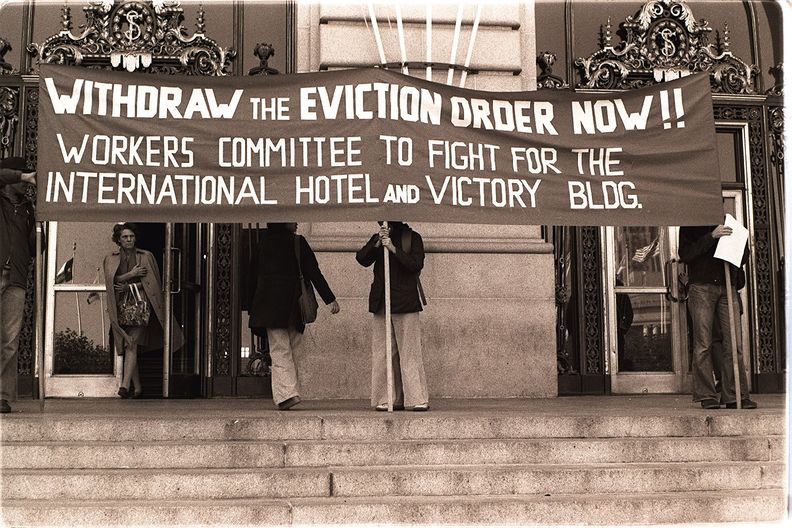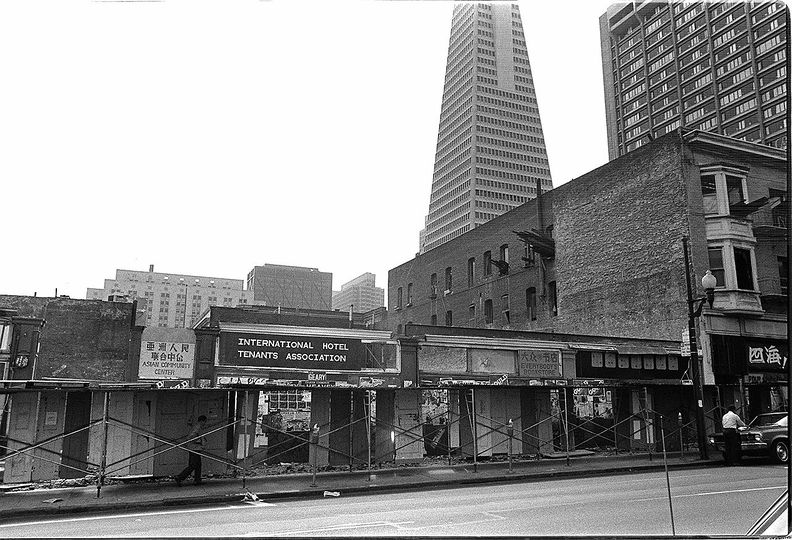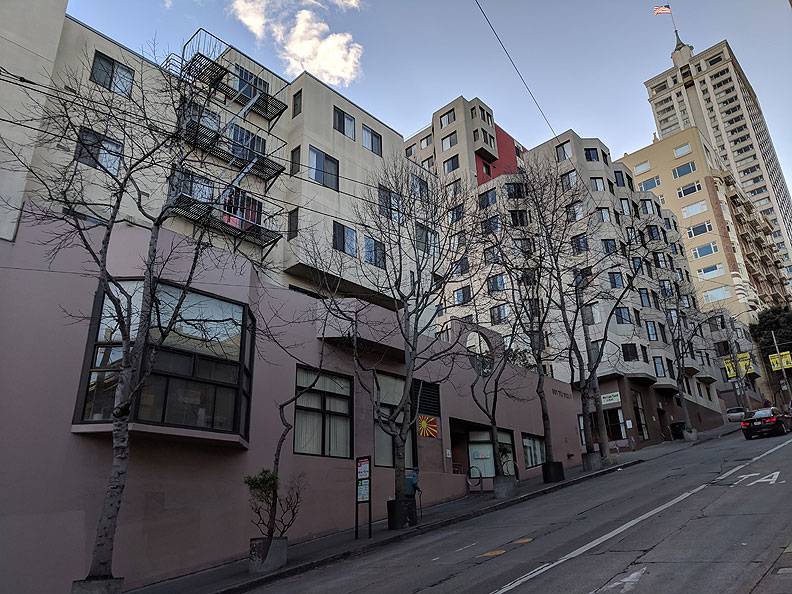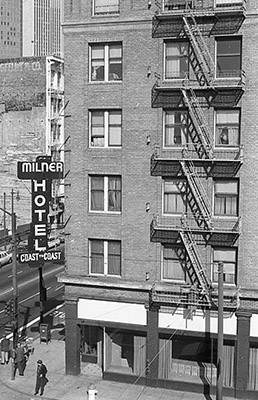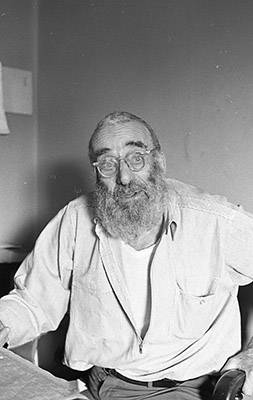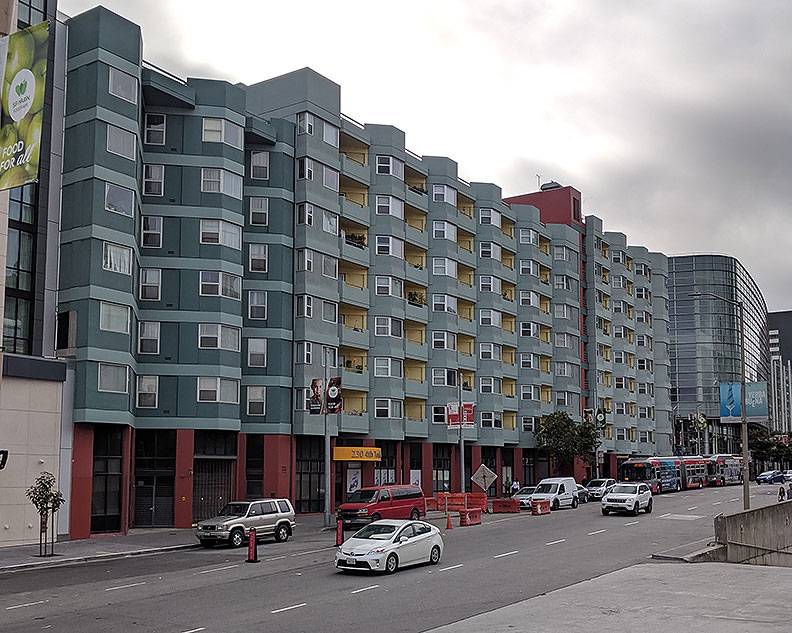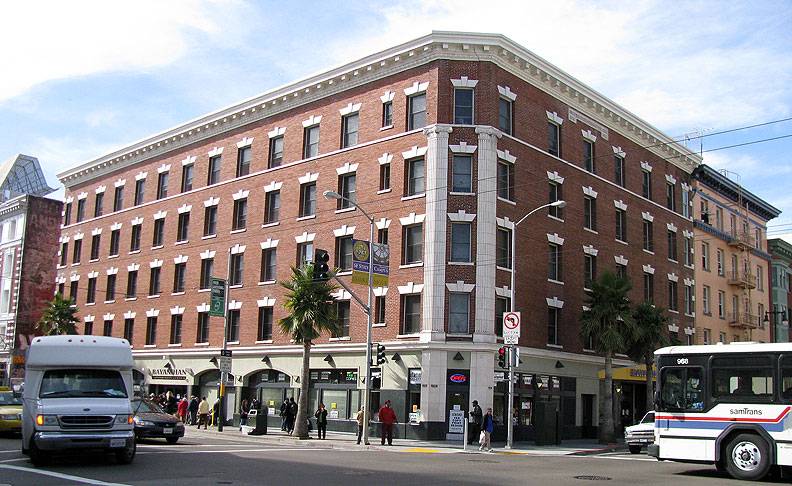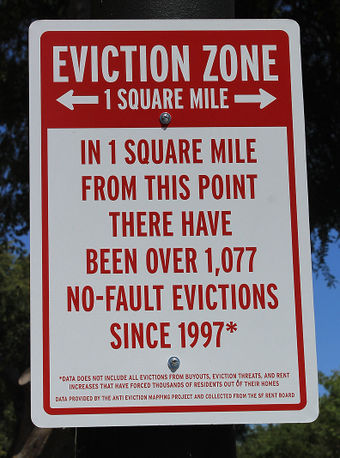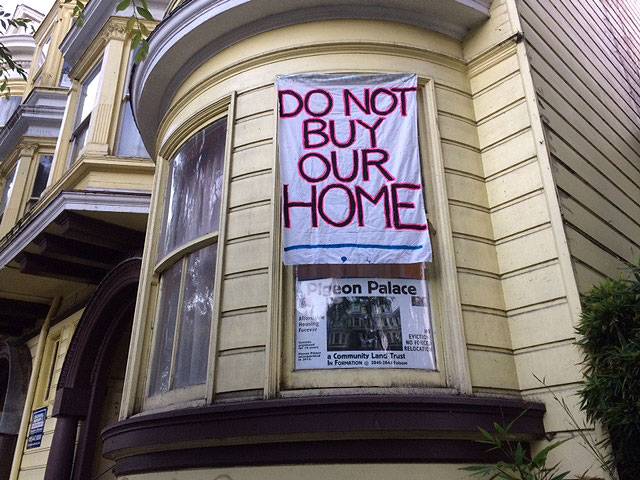Gimme a Home . . .
Historical Essay
by Chris Carlsson, 2019; originally published on Notes From Below
At the anti-eviction protest, May 31, 2019, on Howard Street in San Francisco.
Photo: Chris Carlsson
I arrived early with my 2-year-old granddaughter to a park in central San Francisco. A half hour later others began to arrive and at the appointed time, a group of about 20 dedicated housing activists walked two blocks to a nondescript tech office. One person, pretending to have a package delivery, rang the bell and got the door open. We all quickly filed in to the unsuspecting workplace and fanned out distributing leaflets denouncing a woman (who was thought to work there) for her planned “owner move-in” eviction of the co-director of the Council of Community Housing Organizations (CCHO, pronounced Choo-choo) and his wife and son from their Noe Valley apartment of many years. The office workers there told us that she was hadn’t worked there for over a month, and our direct action effort concluded almost as soon as it had begun. We left fliers behind and asked them to let her know we stopped by. My granddaughter sat on my shoulders gamely clutching one of the handouts, not yet knowing she had just attended her first anti-eviction direct action protest.
Members of our entourage included long-time activists from the Housing Rights Committee, the San Francisco Tenants Union, the Eviction Defense Collaborative, the Anti-Eviction Mapping Project, and the aforementioned CCHO. I was just a body there, but I also sit on the board of the San Francisco Community Land Trust (SFCLT), and am blessed with a low-rent, eviction-proof apartment in the Pigeon Palace, a SFCLT property we got through what we like to joke was one of San Francisco’s biggest recent land heists (by community members rather than profiteers). (After a long, complicated political organizing effort over several years, our building was purchased in a 2015 probate auction by SFCLT with a huge $2.6 million “soft second” loan from Mayor Ed Lee’s Office of Housing and Community Development—something that never would have happened without the surrounding political mobilization in the Mission during the 2013-2015 period in which the purchase took place.)
Looking at housing from an “autonomist” perspective raises the immediate question of the state. Typically, autonomist analyses focus on the direct action of workers in workplaces, or when applied to housing, the focus falls on the direct efforts of tenants and communities to control homes, apartments, buildings, blocks, neighborhoods, and communities. Tenant unions, rent strikes, and eviction defense squads can also highlight a direct action-focused housing politics. Squatting may be the quintessential example of autonomist housing politics, but squatting has never been able to gain anything but very short-term occupations in San Francisco since the 1970s (at least those that have announced themselves—it is thought that there are some ongoing successful squats that have stayed far below the radar). Unlike European cities which have some legal space for seizing abandoned or derelict properties by squatters, the sanctity of private property dominates San Francisco and U.S. politics.
Focusing on everyday people and not on politicians and businessmen makes sense of course. But in the course of decades of bitter conflict over access to shelter, or better, the right to good quality housing, the battle always involves public policy as much as direct action. The basic legal structures and public policies surrounding property and wealth distribution inevitably affect the shape, duration, and results of housing struggles.
Success is not defined very often in autonomist politics. The maximalist goal of total revolution, a mythical end point in which all commodification of humans and the products of our shared labor is abolished, where we collectively and democratically decide about every aspect of our lives, is an enticing chimera that haunts the stunted realities of limited reforms. A utopian future in which every person is entitled to and has a well-made, comfortable, well-maintained home of adequate space in self-organized communities, is far from our current reality.
In the reforms we DO enact, usually via political pressure on elected government, or slightly more directly in ballot propositions (swamped by the distorted claims bankrolled by the other side’s overwhelming financial advantage in campaign spending), gains are consolidated, breathing space is opened, and we can actually feel secure and comfortable in our own homes, whether rented or “owned.” San Francisco has also pioneered a hybrid form of nonprofit housing development corporations that have worked alongside tenant organizing since the 1970s to expand the availability of “affordable housing.”
Both of the stories told here led to ongoing efforts that changed federal and local laws and built real buildings full of permanently low-cost homes, mostly for seniors. Taking a longer view, these struggles also gave rise to two of San Francisco’s most successful nonprofit housing development corporations (Tenants and Owners Development Corporation—TODCO, and Chinatown Community Development Corporation—CCDC) which have gone on to build and rehabilitate thousands of low-cost housing units that to this day allow tens of thousands of San Franciscans who don’t make a lot of money to live here in relative grace.
Social mobilizations at the dawn of San Francisco’s Housing Wars pushed the limits of what was possible at the time. Two memorable fights, each lasting a decade, each dependent on concurrent political movements that cross-pollinated with them and fed mutual inspiration and staying power, show both the power and limitations of housing politics. While gains were made, and worst-case scenarios were held at bay, the seeds of today’s unsustainable housing crisis (as well as some of the best responses to it) are clearly visible in the twists and turns that shaped the fight over Yerba Buena Gardens and the Redevelopment Agency’s agenda for South of Market, as well as the epic battle over the International Hotel (I-Hotel) on Kearny Street. The I-Hotel and Yerba Buena fights both began in the 1960s and culminated in the late 1970s, pushing out the original inhabitants and organizers. However,over the ensuing decades they produced permanent low-cost housing for the kinds of people who had originally put up the fight (albeit not the specific people who actually fought).
I-Hotel and the End of Manilatown
The I-Hotel at 848 Kearny (at Jackson) was a small three-story red-brick residential hotel populated largely by elderly Filipino men, most of whom had come to California in the early decades of the 20th century to work as migrant farm workers or as unskilled labor in the city. They received their first eviction notices in late 1968, and by the time the first date had passed at the beginning of 1969, the fight was on. Years later, on August 4, 1977, the I-Hotel was finally emptied.
Protesters gather in front of the I-Hotel, January 1977.
Photo: Nancy Wong, via Wikimedia Commons
In October 1968, the tenants of the International Hotel received eviction notices, ordering them to be out by the beginning of 1969. The United Filipino Association stepped up to represent the tenants, and over the next months, protest marches, press conferences, and the intervention of local politicians and the San Francisco Human Rights Commission led to the suspension of the eviction. The owner, Milton Meyer and Company (owned by Walter Shorenstein, real estate magnate and major Democratic Party funder), intended to tear down the building and replace it with a parking lot. In March 1969, a mysterious fire broke out that killed three tenants and destroyed the third floor of the hotel. In less than a week, an influx of radicalized students, many just off the front lines of the bloody strike at San Francisco State College, entered the picture, and began refurbishing the hotel. Days later an attorney from the San Francisco Neighborhood Legal Assistance organization filed a suit on behalf of two tenants, arguing that demolition of the hotel violated their constitutional rights but a federal judge later dismissed their lawsuit. During April and May, tenants held protests and press conferences, and rejected Mayor Joe Alioto’s proposals. The tenants benefited from a $50,000 grant given by a Washington DC organization to the United Filipino Association to renovate and restore the I-Hotel. On June 18, a new lease agreement was reached extending the tenants’ residency for three more years through June 30, 1972.
A number of organizations established activities in the building during the stable lease years, including the Manilatown Information Center, Wei Min She, I Wor Kuen, Everybody’s Bookstore, Asian Legal Services, the Kearny Street Workshop, and a new Chinatown Cooperative Garment Factory. UC Berkeley students and San Francisco activists churned out posters and broadsides in support of the tenants’ struggle. Anticipating the end of the lease, a new group, the International Hotel Tenants Association was founded in Spring 1972, and they began clamoring at Shorenstein’s downtown offices and elsewhere for a new lease. When the owners refused to agree to any new leases, month-to-month rents began on July 1, a system that prevailed for another 15 months until Fall 1973, when the Four Seas Investment Corporation bought the I-Hotel from the Milton Meyer and Company.
In September 1974 Four Seas ordered the eviction to proceed, and during the rest of 1974 and into 1975 legal skirmishes and protests filled the streets and courtrooms. By March 1975 the company obtained a city demolition permit, but given the intransigence of the tenants and their supporters, no action was able to proceed. In early 1976 the permit expired. In spite of this, the city’s chief building inspector refused to cancel the permit, and further legal judgments went against the tenants. Appeals to the State Supreme Court were ultimately unsuccessful, but the political pressure led Mayor George Moscone to propose a nonprofit take over the I-Hotel, a plan approved in October by the city’s Housing Authority. In November 1976, the City approved spending $1.3 million in federal funds to acquire the I-Hotel, but a local judge ordered the sheriff to proceed with the eviction. When Sheriff Richard Hongisto and Undersheriff James Denham refused to carry out the eviction they were charged with and convicted of contempt of court, leading to their brief imprisonment in April 1977.
Housing activists protest outside San Francisco City Hall, 1977.
Photo: Nancy Wong, via Wikimedia Commons
Meanwhile, the San Francisco Board of Supervisors voted unanimously to condemn the I-Hotel, and use eminent domain to force the sale of the building to the city, and then resell it to the tenants’ nonprofit organization. Mass demonstrations of thousands of supporters were held outside the building several times in January 1977. Months of legal battles culminated in May 1977 when a superior court judge rejected the Housing Authority’s case for eminent domain. The eviction order was stayed while appeals moved up the courts during the early summer. The I-Hotel was placed on the National Register of Historic Places in mid-June. At the end of July 1977, the State Supreme Court dissolved all legal barriers to the immediate eviction of the tenants, despite the fact that appeals were still pending.
On August 4, 1977, beginning in the post-midnight hours, a massive force of police and sheriffs were brought to the I-Hotel to carry out the long-postponed and highly contested eviction. Thousands of supporters, mobilized by phone trees, filled the streets surrounding the building and withstood hours of police charges before finally giving way to the state violence. On November 8, 1977, Proposition U, a policy statement asking voters whether the city should buy the I-Hotel, bring it up to code, and turn it over to the Housing Authority for low-rent housing, was defeated. When Four Seas began the demolition of the I-Hotel a month after the eviction, they were fined $500 and placed on two years probation for attempting to do it without a valid permit. The final demolition wasn’t completed until Fall 1979, after which the property sat vacant as an empty hole at Kearny and Jackson for more than 20 years.
International Hotel at 848 Kearny Street in San Francisco during its demolition in 1979.
Photo: Nancy Wong, via Wikimedia Commons
Thus ended a nine-year battle to save the I-Hotel. Almost three decades later, in 2005, a new I-Hotel apartment building opened as permanent low-income senior housing. The ground floor was given to the Manilatown Heritage Foundation, a repository of oral histories, recordings, and papers from the arduous and epic struggle to save what had been the last bastion of a one-time ten-block-long Filipino neighborhood along Kearny Street1. The new I-Hotel is an apartment building full of low-income seniors, but is far removed from the community it once anchored. Most Filipinos in San Francisco now live in the South of Market, or in the south and southwestern parts of the City, up to and over the boundary in Daly City.
Many of the Chinatown organizers who began with the I-Hotel battle followed a path that led to a long-term successful effort to stabilize their community and build political power via both senior and youth organizing. Some of the young Asian-American activists who worked to save the I-Hotel also got involved in organizing tenants in Chinatown, creating the Chinatown Coalition for Better Housing. Utilizing local planning and zoning studies, they were able to build public support for low-cost housing developments in Chinatown. Alongside these efforts, public housing tenants at Ping Yuen went on strike in 1978 primarily to get new security measures and overdue maintenance, as well as bilingual staff. Their attorney at the time was a long-haired radical by the name of Ed Lee who decades later, transformed into a quintessential mainstream politician, became mayor in 2011, and declared his goal of seeing 30,000 new housing units built during his tenure (he died in office at the end of 2017), which unleashed the building boom we are still living through now.
After the I-Hotel battle eventually a number of volunteer organizations merged and became the Chinatown Community Development Corporation (CCDC). Gordon Chin’s retrospective book Building Community, Chinatown-Style is a surprising analysis, full of the twists and turns that led him and his many collaborators from their street-level left-wing organizing in the mid-1970s to a decades-long successful negotiation of the intricacies of local, state, and federal power and money.
“We started out in 1977 as organizers, working with the grassroots coalition of five volunteer activist groups and later helping to form new volunteer, resident, or youth-led associations. I consider myself more of a community organizer. And let me be clear, I am of course very proud of the many roles Chinatown CDC has played—community planning, housing development, property management, resident services, and public policy advocacy. But without community organizing, we would not be able to plan for Chinatown with the active vision of all community stakeholders. Without community organizing, our housing development projects would not have the resources needed to build housing that have come from successful housing revenue campaigns. Without community organizing, our advocacy work would be lacking the legitimacy of resident leadership…. In 1998, Norman Fong attended an organizing training with Alinsky-trained organizer Mike Miller. Miller said the challenge for the future of community organizing is the need to create and sustain permanent community-based associations for the long term.”(1)
And Miller would know. He was the executive director of the Mission Coalition Organization during its five years of tumultuous political organizing in the Mission District, 1968-73. Heralded as the largest grassroots mobilization in any city neighborhood in history by the Spanish sociologist Manuel Castells,(3) the MCO splintered under the pressure of over 100 constituent groups arguing over how to direct the millions of dollars in “Model Cities” money that Mayor Alioto put in their hands. The MCO experience still echoes through the years, but the more successful and long-term effort by Chinatown community organizers hasn’t enjoyed the same notoriety.
Mei Lun Yuen apartments.
Photo: Chris Carlsson
A major housing project for low-income seniors called Mei Lun Yuen was built at the northern end of the Stockton Tunnel over the disapproval of the wealthy residents further up the slopes of Nob Hill. Beginning with the first appearance of organized Chinese senior citizens at City Hall in 1972, a decade later and after much bureaucratic maneuvering and arm-twisting, the apartment complex was built. Following the success of this project, and ongoing collaborative efforts to preserve Single-Room Occupancy residential hotels (SROs), the CCDC expanded into the northeastern neighborhoods of San Francisco and took on a number of other projects, not only on behalf of Chinese residents. As Chin remembers, “With a growing portfolio of affordable housing projects, the roles of property management, asset management, and resident services became critically important. By the end of our second decade, Chinatown CDC was managing 16 buildings housing more than 1,800 residents.” (4)
Years later, the new 15-story I-Hotel opened in 2005 with 104 units of low-income senior housing, the design and construction overseen by the CCDC. By then, the CCDC had become a major housing developer in the area, helping to launch the first San Francisco Community Land Trust project, housing 21 families, the Asian Law Caucus and Asian Neighborhood Design down the street at 53 Columbus in 2003. Building on their success they’ve expanded their influence into other parts of the city. Among their efforts include over a hundred units of senior housing at 870 Turk Street in the old freeway right of way that became the Octavia Boulevard Plan, and a 236-unit apartment complex in Mission Bay, the largest “affordable” project in the new neighborhood. While it’s not a direct line, it’s difficult to imagine the Chinatown Community Development Corporation existing apart from the extraordinary political battle around the I-Hotel in which many key organizers all began back in the 1970s.
Yerba Buena Redevelopment
Today’s Yerba Buena Gardens sits atop the Moscone Convention Center, and is at the heart of a thriving museum district. The Center for the Performing Arts and the Yerba Buena Museum are part of the main blocks surrounded by 3rd and 4th, Mission and Folsom, along with the Children’s Zeum, an ice rink and carousel, a Martin Luther King Jr. memorial and waterfall, a 2.5 acre lawn with free public music shows, and the Metreon mall on the northwest corner. The SF Museum of Modern Art is east across 3rd Street, and the Contemporary Jewish Museum is in the old PG&E substation on the north side of Mission, to be joined soon by the Mexican Museum currently under construction. The Museum of the African Diaspora and the California Historical Society are just east on Mission past 3rd Street. In the early 1960s, when the San Francisco Redevelopment Agency (SFRA) laid out its vision for these central city blocks, none of this was on the drawing board except a version of the Convention Center. The public amenities such as the Children’s Museum (Zeum) and the ice rink, along with the two Yerba Buena Center (YBC) cultural facilities, were all achieved as a result of years of struggle and legal actions that blocked the original vision of the SFRA, which would have built a modern sports arena or stadium surrounded by highrise offices along with the planned convention center. Today’s neighborhood also houses several large low-cost senior housing projects, all built before any Yerba Buena Gardens facilities were complete. This happened in response to successful legal action taken on behalf of the organized tenants of the former SRO hotels that filled these same blocks before Redevelopment.
The San Francisco Chronicle and San Francisco Examiner both began running pro-redevelopment articles in the mid-1960s, emphasizing that the neighborhood was run down and derelict, populated by winos and bums. That was not well received by the actual residents of the hundreds of SRO rooms in the local hotels along Mission, Howard, Third Street, and Fourth Street. Retired sailors and longshoremen made up a significant portion of the residents there, men who had worked long and hard since before WWII, and were enjoying their retirement years living among old working pals and friends with similar histories in the neighborhood. Many of them had been strikers during the Big Strike of 1934 and the subsequent labor actions that led to the thriving union movement that gave San Francisco its reputation as a labor town.
Milner Hotel, 117 4th Street at Howard, 1970.
Photo: Lee Sims collection, San Francisco History Center, San Francisco Public Library, TOR-0069
When residents began meeting in the summer of 1969 in the lobby of the Milner Hotel, considered one of the better of the area’s hotels, they had a lifetime of self-confident militancy to draw on. Out of their meetings they established a new organization, Tenants and Owners in Opposition to Redevelopment (TOOR). What they perhaps didn’t fully grasp at the time was how much the labor movement they had helped build in previous decades had become a key element of the pro-growth political coalition that was behind the plans to demolish their neighborhood.
Peter Mendelsohn addresses TOOR meeting at Milner Hotel, George Woolf sitting in center, December 1970.
Photo: Lee Sims collection, San Francisco History Center, San Francisco Public Library, TOR-0135
In the previous year, the newly elected Mayor Joseph Alioto (a corporate lawyer who headed the Redevelopment Agency in the late 1950s) came into office on a wave of support from San Francisco’s main companies, and most of the biggest unions in town, too. Specifically the International Longshoremen’s and Warehousemen’s Union (ILWU), a bastion of radical unionism stretching back to its origins in the Big Strike of 1934 and the many militant strikes that followed, had by the late 1960s become integrated into the city’s pro-growth consensus. As Chester Hartman clearly delineates in his magisterial analysis of San Francisco housing politics City For Sale: The Transformation of San Francisco (UC Press: 2002):
“An ILWU Local 10 official was appointed to Alioto’s cabinet. ILWU International president Harry Bridges was appointed to the San Francisco Port Commission. Hector Rueda of the Elevator Construction Workers Union was appointed to the Planning Commission. Bill Chester of ILWU was made president of the BART system. In late 1969, the San Francisco Redevelopment Agency awarded the ILWU a choice lot in the Western Addition A-2 redevelopment area to build its world headquarters. Local 261 also received its rewards: the head of the Centro Social Obrero was appointed to the mayor’s cabinet; the local’s president went on to the Housing Authority’s board; and a leader of the Mexican-Ameriacn Political Association was appointed by the mayor to fill a vacancy on the Board of Supervisors, another to the Board of Education.” (5)
George Woolf
Photo: Lee Sims collection, San Francisco History Center, San Francisco Public Library, TOR-0092
The first president of TOOR was George Woolf, a octogenarian labor militant who had once led the Alaska Cannery Workers Union (which was eventually absorbed into the ILWU). He was a no-nonsense person with a long pedigree of engaging in collective actions. Another early leader who eventually succeeded Woolf was Peter Mendelsohn, a long-time sailor who had gone door to door in the 1950s to raise money for ILWU President Harry Bridges’ legal defense when he was repeatedly accused by the federal government of being a communist. Mendelsohn penned a letter from TOOR to Harry Bridges at the height of their effort to resist the Redevelopment Agency’s plans to tear down their homes:
“‘We are your Brothers,’ they wrote. ‘We fought the bosses together. We stood with you against the police and strikebreakers on the Embarcadero during the General Strike. We sailed with you in the Merchant Marine during the War. The Redevelopment Agency is taking our homes. It’s all we have. We need your help.’ Bridges had returned the original letter, with a handwritten answer in the margin, ‘Sorry, but I’m on the other side [in] this, Harry.’”(6)
Discouraged by the lack of union support, the local residents who founded TOOR were determined to resist. These elderly men knew that their presence in these hotels was their strongest leverage and they were not going to give it up easily. Neighborhood Legal Assistance lawyers filed lawsuits on their behalf and a federal judge took their position seriously, blocking the San Francisco Redevelopment Agency’s (SFRA) plans. The flaw in TOOR’s strategy was summed up by Chester Hartman (who was himself deeply involved in TOOR):
TOOR by and large adopted the principle that “lawyer knows best” and placed its fate in the hands of its professional advocates, regarding their judgment and skills as superior to those of the community. The lawyers by and large seemed to share this assessment. They neither sought nor were given adequate guidance by the community and were in the position of making the political decisions that, under a strong community organization, they would not have been permitted to make. In this situation, the style, predilections, and values of the attorneys came to dominate the outcome. (7)
At the beginning of the 1970s, lawsuits and negotiations were not getting anywhere. The federal government was not offering enough subsidy money to allow the SFRA to live up to legal commitments it had already accepted regarding new low-cost housing. When the City of San Francisco offered local funds from the hotel tax to subsidize the units, the SFRA was able to build the legally required housing. In June 1979 Woolf House I (named after George Woolf who had by then died) opened, a nine-story, 112-unit building with storefronts along 4th and Howard Streets.
Woolf House II at 250 4th Street in 2017.
Photo: Chris Carlsson
The developer was TOOR’s successor organization, Tenants and Owners Development Corporation (TODCO). A 70-unit expansion, Woolf House II, opened next door in 1982, and a third part was added 1996. TODCO’s Mendelsohn House was opened in 1988 on Folsom just south of the Moscone Convention Center consisting of 189 well-built apartments overlooking an 18,000-square-foot public community garden cession in midblock. In 1977, bureaucratic rules forced TODCO to give its fourth location (across the alley from Mendelsohn House) to a Filipino organization, where they built 147 senior apartments under separate management and ownership. These four developments resulted from TOOR’s successful fight against the original relocation plans and to this day are providing more than 600 units of low-rent units to 850 residents. TODCO has gone on to rehabilitate the Knox Hotel, Hotel Isabel, the Leland, and the Bayanihan House at 6th and Mission, all providing long-term low-rent housing to hundreds of area residents.
Bayanihan House at 6th and Mission, 2009.
Photo: Chris Carlsson
The Yerba Buena area today is dominated by the museums and public amenities above the Moscone Convention Center along with the luxury towers, offices, and hotels that have sprouted up in adjacent blocks. But some diversity was preserved by the epic battles of the original evictees of the neighborhood. Six hundred apartments sounds good until you note that in the decade they were mostly built, Planning Department data shows that the city lost more than 17,000 affordable rental units that were converted to condominiums or commercial use. In roughly the same period the number of SRO hotel rooms fell from 33,000 to 19,000, until the 1989 Loma Prieta earthquake destroyed another ten hotels, adding to the loss of low-cost housing.
Chester Hartman describes the final balance in his account of the TOOR/Yerba Buena fight:
“Very few were able to occupy the replacement units, which in themselves amounted to less than one-quarter of the units destroyed. And the only reason the residents gained as much as they did (or lost as little as they did) was through a combination of refusal to give up possession of the turf they occupied until maximum concessions were wrought (a function in no small part of their particular labor union backgrounds) plus an aggressive use of the courts that was characterized by a near perfect, and therefore atypical, combination of an excellent fact situation, a sympathetic, steadfast, and courageous federal judge, and exceptionally talented and tenacious (and free) attorneys.” (8)
Both struggles became iconic moments in 1970s San Francisco, and both ended in tragedy for the people who mounted the most spirited fights. But due to the curious dialectics of urban development, both also led directly to hundreds of new units of low-rent housing. Activists who suffered defeats at the I-Hotel or in the Yerba Buena battle largely became the backbone of the ongoing movement of housing organizations, both tenants rights and nonprofit development corporations and their political allies. The new nonprofit housing organizations (TODCO, CCDC, Mission Housing and Development Corporation (MHDC), Bernal Heights Neighborhood Center (BHNC), Tenderloin Neighborhood Development Corporation (TNDC), and others (the Council of Community Housing Organizations has 26 member groups altogether) have played an important role in San Francisco’s ongoing development. They have helped to preserve dignified housing for thousands of the city’s less affluent residents, and built and preserved more than 25,000 units of low-income housing in the past decades. In both North Beach and South of Market, new low-cost housing has also contributed local stimulus to new market-rate, profitable developments that fed the larger dynamics of neoliberal gentrification. It’s been a fraught process, to say the least.
A Worsening Half Century: Who Gets To Stay (Home)?
The long housing crisis that dates from the 1970s to the present corresponds closely to the advent of the neoliberal era. The federal government’s steady retreat from housing support has not been replaced by state and local governments. This has resulted in the emergence, since the beginning of the 1980s, of a growing homeless population in most major US cities. The sharp increase in capital flowing into real estate, both residential and commercial, during the past decades, has unhinged a century-long stability that kept the upward trajectory of housing prices and wages moving together. Housing prices have raced far ahead of income, leaving most San Franciscans locked out of moving to new homes, either rentals or owned. As George Monbiot recently noted in a column, where it once took a working class family in England about three years to amass enough to start buying a home, it now takes an average of 19 years! (9) Similarly impossible numbers confront people in U.S. cities too.
Guerrilla installation at Folsom and 24th in the Mission.
Photo: Chris Carlsson
San Francisco is worse than most places since it has been the deliberate policy of the political leaders to stimulate “Manhattanization” and the expansion of downtown as a source of jobs, while doing very little to plan for the inevitable increase in needed housing. Facing the city’s stubborn unwillingness to plan and direct housing construction, organizers and activists who came together in 1979 as the Council of Community Housing Organizations put forth the first office/housing linkage ordinance in the country called the Office Housing Production Program in 1981. Decades later, the legacy of this approach is that the city has relied almost exclusively on new inclusionary rules and/or in lieu fees from developers as compensation for allowing them to decide what to build and for whom. Rather than a robust, self-financing public housing sector buying lands and building low-cost high quality housing for its residents, San Francisco, like most U.S. cities, leaves the initiative to private developers. Although the city has long had a vigorous Planning Department, and a Planning Commission that oversees it, private developers still largely set the agenda. If a public interest is identified and sought by city planners, it is assumed that the private developers will adapt to it in exchange for concessions on building height, density, parking, inclusionary minimums, etc. For many decades, the overwhelming majority of new construction has been luxury housing serving the tiny fraction at the top of the income scale. The slippery and vague idea of “affordability” has been defined to apply to families making over $100,000 (magically transformed into the “middle class”) due to the absurdly skewed incomes of the ultra-rich in San Francisco. This leaves the majority of San Franciscans who earn between minimum wage and $40/hr. to fight over the trickle of “below market rate” units required by the deals struck with private builders.
Knowing many of the individuals who populate the tenants rights and anti-eviction movements in San Francisco, I can attest to their dogged persistence and deep knowledge of the intricacies of surviving and sometimes even thriving in one of the global epicenters of wealth accumulation. The tidal waves of money that have washed into the Bay Area and San Francisco in particular have necessarily brought with them shocking levels of poverty, homelessness, and a degradation of life for a significant fraction of our neighbors, both housed and unhoused. Organizations, activists, and lawyers are all overwhelmed by the endless cycles of investment, development, speculation, displacement, eviction, destruction, and despair. Communities have been permanently ripped apart. Friends and family have been banished to the far reaches of the Bay Area or completely out of California. The harsh logic of a housing market that caters to the nouveau riche of the tech, medical, and legal industries while starving public housing and low-cost private housing of investment has dramatically reshaped the demographic make-up of who lives in San Francisco in a few short decades.
Decades-long efforts to address the steady shrinking of low-cost housing affordable to the poor and poorly-paid working classes have had some success. Using lawsuits to extract concessions from developers, and office/housing linkages that pull fees and actual units from luxury developments, the nonprofit housing movement has managed to build over 25,000 apartments since the 1970s. But nobody can look at San Francisco in 2019 without being overwhelmed by the building boom that has reshaped the skyline and many neighborhoods, with construction cranes and cement trucks clogging the city, rushing to put up the latest crop of highrises before the next downturn hits.
The same 2019 gaze will also fall on the grinding poverty that has expanded in lockstep with the expanding wealth, as some win and many lose in the rigged game of neoliberal urbanism. In spite of a steady undercurrent of political mobilization by tenants and grassroots housing activists, the tide of real estate inflation has continued to rise, and the wreckage of eviction and displacement has continued to push growing numbers into the streets and out of the city. San Francisco now has a wealthier, whiter, and more upscale population to fill the renovated Victorians and the rapidly expanding supply of luxury apartments, while long-time residents have lost their apartments and find themselves in the streets, or in other parts of the country.
The current politics of San Francisco’s housing crisis has been further muddled by the eruption a few years ago of a self-styled grassroots millennial movement demanding that housing be built anywhere and everywhere by the private market, and that all efforts to plan or control land-use be removed to allow the market to do its “magic.” This “yes-in-my-backyard” or YIMBY movement (better described as “Yes In Your Backyard,” since they are in favor of policies that fill in backyards and all urban open spaces with still more market-priced housing) has had limited success at electing local candidates or pushing successful ballot propositions, but they have become media darlings and enjoy support from the center-right power block that controls the mayor’s office regardless of the race or gender of the actual politician. In a city where every elected politician is a Democrat, everyone claims to be focused on the housing crisis, and we’ve passed new taxes, bond propositions and other initiatives at the ballot box in each of the last several elections, there is nevertheless a palpable sense that the soul of the city is being systematically evicted, displaced, and drained away.
Small direct actions like the one described at the beginning of this article continue to affect specific buildings and occasionally succeed at stymieing evictions, altering owners’ plans, and discouraging purchases by people who don’t want to face entrenched opposition, etc. But such piecemeal opposition is fighting an endlessly defensive battle. San Francisco’s land use, dominated by the priorities of the wealthy and a booming construction industry focused almost exclusively on a “market” that only the very rich can afford, has produced very little building for people who have lived and worked in the city for many years. The ethnic- and class-cleansing project of the city’s leaders, dating back to the 1950s, has passed a point of no return. Black San Francisco has fallen from a population of nearly 100,000 in 1970 to less than 35,000 today. Latino San Francisco grew steadily into the early 2000s, but has been falling ever since. The 2020 census is bound to reveal a shocking decline of Latinos in the Mission where young high-paid workers have poured in and driven out many long-time residents.
The fight to stay goes on unabated, resembling a scramble up a sandy slope only to keep sliding backwards. When victories are won, they are isolated and on behalf of specific individuals, not systemic changes to the politics and economics of housing. Tracing a half century arc to the founding struggles of San Francisco’s progressive housing movement sheds light on the class dynamics that anchored it. Though working and middle-class San Franciscans, mostly renters, have repeatedly tried to push public policies that would block speculators, discourage luxury developments, and promote “affordable” housing (a term that has been rendered meaningless by recent redefinitions promulgated by the Mayor’s Office of Housing), a half century later, the housing crisis dominates local politics. A municipal housing agenda is the current mayor’s first priority, and enjoys wide support from the city’s board of supervisors too. It may be too little, too late, which it certainly is for the many San Franciscans who already left.
It Ain’t Over til…: The Strategy of Urban Housing Land Trusts
The demographic reshaping of San Francisco is not complete, but it has progressed very far. The political majority in town has repeatedly voted in moderate vs. more left-wing candidates for mayor, though a majority of the current board of supervisors generally lean to the progressive side of the spectrum (as opposed to their “moderate” opposition in the minority these days). Property rights remain inviolable, and even if they are challenged (as they were by the efforts to invoke eminent domain in the I-Hotel struggle in 1977), it is beyond imagination to think that higher courts would endorse any erosion of the absolute power of property owners.
Thousands of former rental units are now being used for short-term tourist rentals, further shrinking the availability of housing. Hundreds of million-dollar luxury apartments stand empty most of the year, owned as pied-a-terre’s by the global elite, called “safe deposit boxes in the sky” by a recent New York Review of Books scribe. (10) Empty malls and dying storefronts are advancing as quickly as new apartments are being thrown up along major thoroughfares.
Efforts to create good quality housing for everyone are going to confront private property at some point. A non-market approach that challenges private property in a fundamental way has recently emerged in the form of community land trusts. The idea is not brand new, but it has recently gained traction in a number of locations (full disclosure: I live with my wife in a San Francisco Community Land Trust building that was purchased in 2015; our rent for a large Victorian flat is less than $1300/month for an apartment that would rent for $6,000/month in the open market, and we are essentially eviction-proof as long as we pay our monthly rent). The model is based on the idea that by purchasing buildings and putting the land underneath them in permanent trust, the value of the building is lowered, allowing for lower rents. Since the building can never be sold again, the lower price housing it represents is comparatively permanent. The model takes things a step further when it leads to the former tenants becoming limited equity owners of their own flats who self-manage the property in a new cooperative association that holds the long-term lease on the building.
The San Francisco Community Land Trust (SFCLT) has acquired 13 buildings since its inception in 2003, but it is severely constrained by a lack of working capital. Its ability to acquire and manage properties has been completely dependent on getting “soft second” loans from the Mayor’s Office of Housing and Community Development (MOHCD), which gives that bureaucracy a controlling interest in each project. As we’ve learned the hard way, MOHCD is intractably opposed to tenant self-management, and has forced SFCLT to agree that an eventual conversion to co-ops will not happen in most of its buildings. Instead, under coercive financial pressure from MOHCD, the Land Trust has become a property manager and landlord to the residents of its buildings. This is not ideal, to say the least. Land Trust residents, with some notable exceptions (including our building, the Pigeon Palace) are not necessarily predisposed to a self-managed future. In most of the properties, the acquisition was not driven by organized tenants as much as by the efforts of SFCLT to expand its portfolio. But according to the bylaws of the SFCLT, it is the purpose of the organization to hand off the buildings it acquires to self-managed co-ops of tenants, while retaining in perpetuity the land ownership under the buildings. Until the political impasse is resolved with MOHCD, there will be no new self-managed co-ops.
Signage during our anti-eviction struggle at the Pigeon Palace, 2015.
Photo: Chris Carlsson
The existing situation is deeply flawed, but it doesn’t mean that the concept is itself unworkable. It requires a more aggressive and far-sighted city administration to put the SFCLT on a solid financial footing, and then to support its efforts to find tenants who want to fend off speculative purchases of their buildings when existing owners die or decide to sell. Over a period of years, it is not hard to imagine whole rows of homes, even blocks and contiguous areas converting to land trusts, slowly expanding the quantity of properties that have been permanently and irrevocably decommodified. In a city that is suffering a terminal displacement crisis, this would crucially stabilize communities in a way that many people call for, but no one seems to have an idea about how to achieve. Land Trusts give tenants facing economic displacement a real shot at being able to stabilize their residence and to make a multi-generational home in San Francisco. Without removing buildings from the voracious jaws of the private property marketplace, it’s hard to see how the processes that have already gone so far won’t continue.
Public officials have long presided over a wild west marketplace that has led to ethnic- and class-cleansing. A systemic approach to reverse this decades-long process will require a huge political surge from below, but the contours of a potential program are clear. By removing properties from the open market and putting them in permanent land trusts, communities can be given the breathing room they need to stabilize and remain. Once footholds of land trust sustained social housing takes root in various neighborhoods, public policy should be committed to helping expand the number of properties that leave the market forever, and become a foundational part of a San Francisco worth living in and a San Francisco worth fighting for.
Proper public planning coordinates and allocates resources in sane ways, e.g. that creates high quality housing (and free, fast and universal public transit, free hi-speed internet, low-cost electricity, free education, a public bank to underwrite expansion of our shared commons, etc.) available to all. Expanding our common wealth in this way can only be done by taking the resources hoarded by the ultra-rich and putting them to work for everyone.
Oh, sorry, that would be commonism!
Notes
1. Beyond the scope of this article, but worth noting, Filipinos became a large immigrant group in California during the first half of the 20th century after the United States forcibly colonized the Philippines. After a brutal years-long war of pacification against Filipino nationalists seeking independence, the sordid history of the savage U.S. conquest was obliterated by obscuring it as a small chapter in the “Spanish-American War”.
2. Chin, Gordon. 2015. Building Community, Chinatown-Style. Chinatown Community Development Center, San Francisco, CA. p. 190
3. Castells, Manuel. 1983. The City and the Grassroots. University of California Press, Berkeley, CA.
4. Chin, Gordon. Op.cit. P. 183
5. Hartmann, Chester. 2002. City for Sale: The Transformation of San Francisco, University of California Press, Berkeley, CA. p. 30-31
6. Ibid. p. 70fn
7. Ibid. p. 83
8. Ibid. p. 396
9. Monbiot, George. June 4, 2019. “Want to Tackle Inequality? Then First Change Our Land Ownership Laws” UK Guardian
10. Filler, Martin. April 2, 2015. “New York: Conspicuous Construction” New York Review of Books Vol. 62, No. 6.


